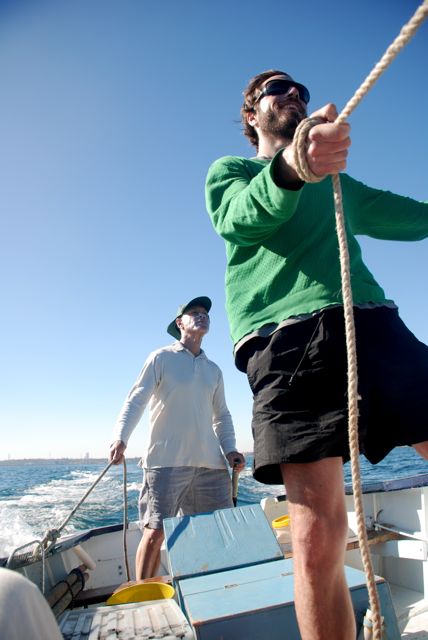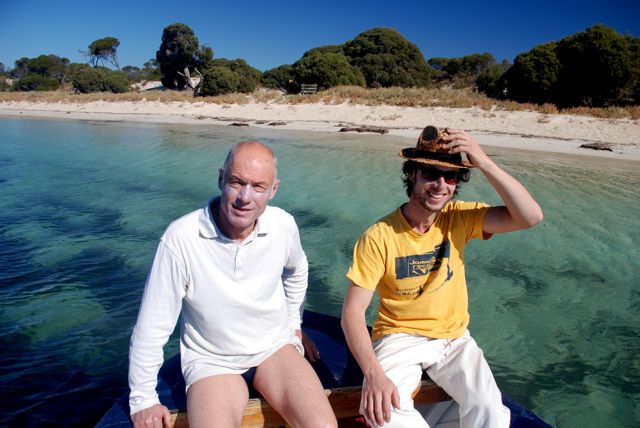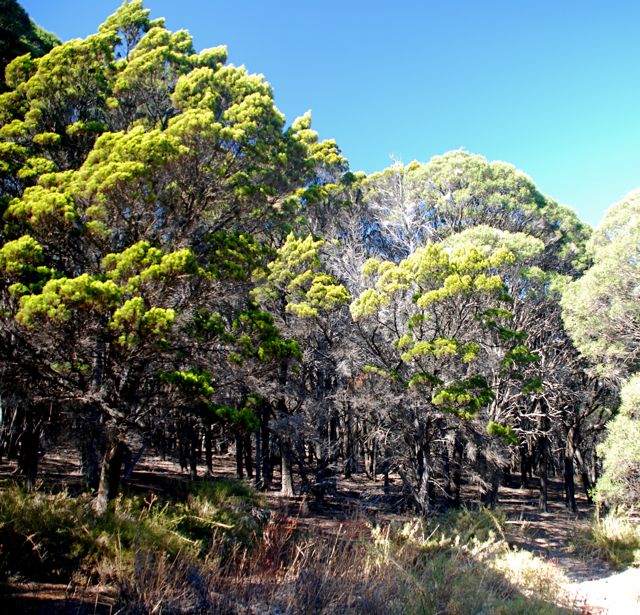This morning I, my friend Danny and my dad went out on my dad’s boat to Garden Island to do some snorkeling. It was a calm, sunny May day on Cockburn Sound, and spirits were high. We piled our sundry gear into the bottom of the little wooden boat and lowered it into the water at Woodman’s Point, south of Fremantle. My dad steered us out past the rocky groin: onto the ocean, sun high, eyes glinting with sea shine. Three men in a boat. Heading out.
The Indian Ocean spread out all around us. Dolphins periodically slid their grey flanks out of the water in front of us, allaying any peripheral anxiety my dad’s talk of recent Great White sightings may have sparked. Dophins don’t hang out with sharks, as a rule.
We made our way to the island, the skipper bumping and sliding us over the chaotic dimples of the sea with practiced ease. The island has been an island for something like seven thousand years when the sea swelled and covered up most of the Swan coastal plain, leaving a few limestone lumps a far distance off our contemporary shore. The Nyoongar people didn’t have boats, and this meant the island we were about to arrive at had not been burnt by humans with fire sticks in centuries past. What we were seeing as we approached the sand beach of Garden Island’s north-eastern side was what the approach to Fremantle might have looked like a very long time ago. Funny, although I live very close to it, I have never stepped onto Garden Island.
Arrival. Stepping onto the sandy shore. Walking into the forest.
There are hardly any places were you can see Melaleuca lanceolota (ti-tree) and Callitris preissi (native pine) growing in thick stands with closed canopies. These trees haven’t been molested by fires and humans with axes or bulldozers. In fact the state categorizes this vegetation type as a Threatened Ecological Community. These almost unique remnant forests stand as a reminder of what parts of coastal Fremantle and Perth once looked like.
Looking up into the canopy the ti-tree’s sillouette looked slightly gothic.
 But as I stood below amongst the trees, feeling the soft sand and brown moss beneath my bare feet, hearing the chuckle and crash of the surf beyond the dunes embroider the forest peace and stillness, I felt happy. The shadows here didn’t hide any grief or pain in their depths.
But as I stood below amongst the trees, feeling the soft sand and brown moss beneath my bare feet, hearing the chuckle and crash of the surf beyond the dunes embroider the forest peace and stillness, I felt happy. The shadows here didn’t hide any grief or pain in their depths.
Later I was snorkeling and floating above a glowing nudibranch. My eyes were focused attentively on the iridescent aqumarine of its little body amongst the sea grass. The colours of our local nudibranch are worthy of the most spectacular tropical reef ecosystems. When we were on the boat at one point somebody spied a sea turtle from afar. We approached, only to catch a few seconds of the old, barnacle encrusted voyager before he span and flapped his way down into the blue.
Later in the afternoon some wind had picked up from the south and we made our journey back. The boat shot forward. Danny stood, leaning back and holding on steadfastly to his rope, grinning at the surging force beneath his feet. My pa held the tiller and steered us onto the faces of waves we could ride, and over the crests of those we couldn’t. I clung to the old, blue rail of the little craft and looked at the sea water slap and spray out to the side of the hull. The blue water shot beneath us. Water shot out to the side. Water shot into our faces. I was still wearing my wet suit after the snorkeling earlier – not that the water was very cold today – and we were all catching plenty of sea spray onto our dripping and smiling mugs. Close up and personal with the big blue. Three men in an ocean-going little boat. No insulation, no isolation. I put my hand into the plumes of spray we were kicking up, and watched the tiny rainbows that sometimes appeared.


